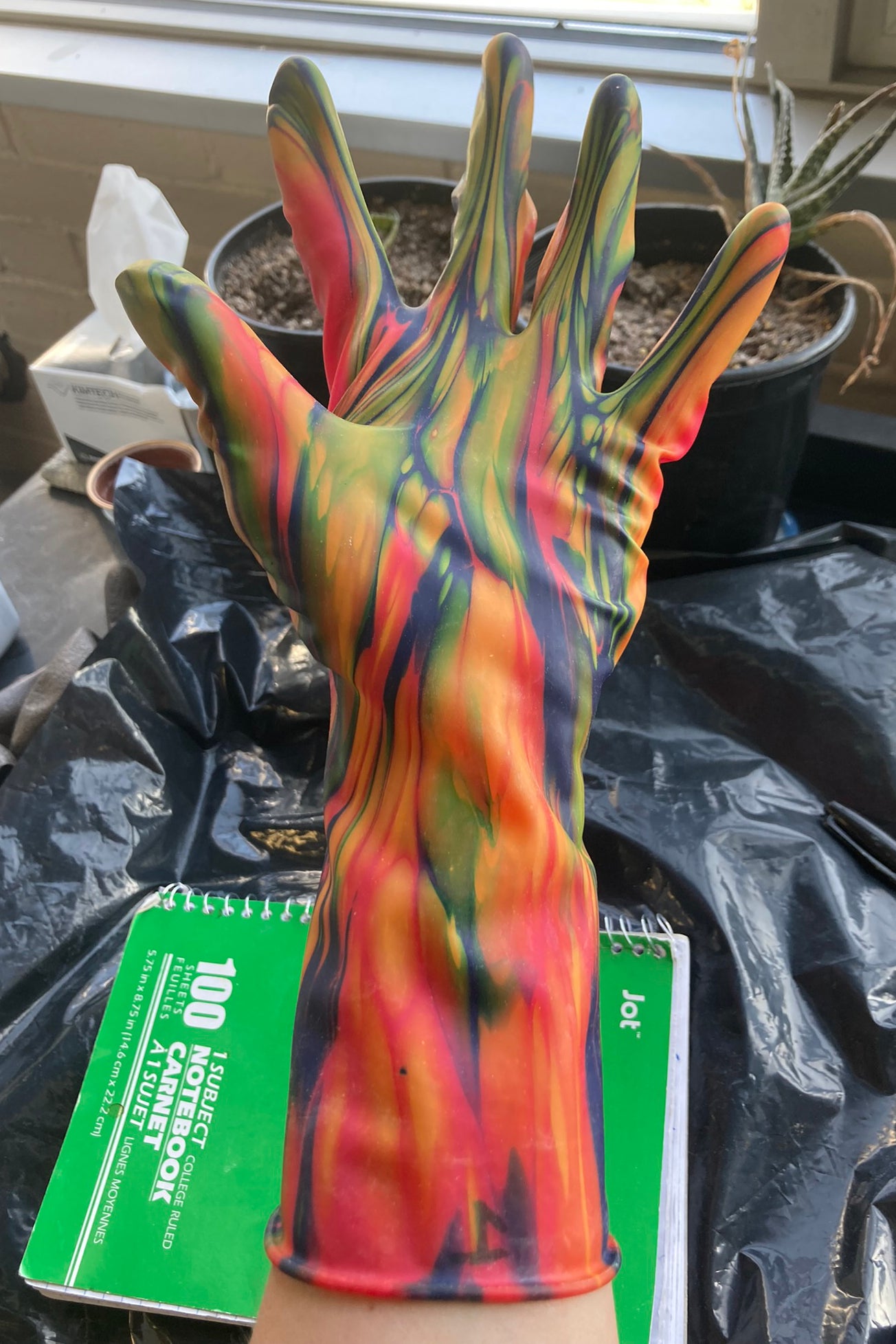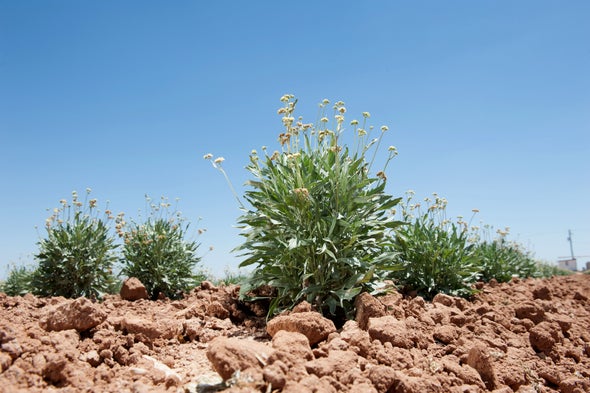The sage-green, waist-high shrub guayule might look like just one of the many scraggly bushes that dot the hills and valleys of the Chihuahuan Desert in Mexico and the southwestern U.S. But its nondescript stalks and leaves harbor a panoply of botanical treasures, including rubber that Indigenous people used hundreds of years ago to make balls for games.
For decades, researchers have been investigating guayule (Parthenium argentatum) as a potential commercial source of natural rubber. The market is currently dominated by rubber sourced from Hevea brasiliensis trees in Southeast Asia, and it’s hard for guayule in the U.S. to compete with those large operations, which have lower labor costs. Farmers in the Southwest tend to favor more lucrative crops, such as alfalfa and cotton.
But two converging developments may be about to change guayule’s prospects. Fungal infestations of monocultured Hevea trees have caused steep drops in global natural rubber supplies in recent years. Meanwhile the Southwest’s worst drought in more than a millennium has reduced the water available to farmers, making it harder to grow alfalfa, cotton and other thirsty crops. Guayule, on the other hand, is drought-tolerant. And it can be grown and harvested for several years without tilling the soil. That undisturbed soil stores carbon in the ground and prevents erosion.
In an effort to make guayule a more viable crop, researchers in academia and industry are working to increase the plant’s rubber production—while also investigating uses for the sticky resin and woody material it produces. With guayule, “a farmer could still grow things in the desert and still make a living and still protect the soil and protect the water,” says Catherine Brewer, a chemical engineer at New Mexico State University. “There are not many plants that meet all of those criteria.”

The tire manufacturer Bridgestone has operated a demonstration-scale processing facility in central Arizona for the past decade in an effort to show that guayule can eventually be harvested for natural rubber at a commercial scale. In late August the company announced it would commercialize guayule rubber production by 2030. Though two thirds of the world’s rubber is now made synthetically from petroleum, rubber produced from natural sources is indispensable for some purposes. Airplane tires, for example, are made from natural rubber, which is superior to synthetics for handling impacts such as landing on the runway.
Because only a small amount of guayule is currently grown, it wouldn’t be able to compete with Hevea rubber on a broad scale for some time, says Katrina Cornish, who studies alternative rubber sources at the Ohio State University. That means companies that want to use it would need to start with high-value products—such as the guayule-rubber racing tire Bridgestone debuted this year. At her own company, EnergyEne, Cornish focuses on premium products made of guayule latex, a softer form of rubber that the plant also makes. EnergyEne is developing a radiation-attenuating medical glove, for example. On the consumer side, the company has made “lovely condoms,” Cornish adds, including ones that are Cabernet Sauvignon- and Chardonnay-flavored. Guayule makes the best latex, compared with other natural and synthetic formulations, because it’s particularly strong, stretchy and soft, Cornish says. It’s also hypoallergenic, unlike latex derived from Hevea trees. Jason Quinn, a sustainability researcher at Colorado State University, conducted a study in 2020 that found that guayule rubber grown on a typical-size Arizona farm could be cost-competitive with Hevea rubber—though the guayule product’s cost would be toward the higher end of the range of historical Hevea prices.
At Bridgestone, plant geneticist David Dierig hopes to improve guayule’s profitability by breeding plants that bear more rubber. His team has mapped guayule’s genome and identified genes that are associated with higher rubber content. With this information, researchers can select plants with a potential for greater rubber production and cross them before they are fully mature, shortening the time it would normally take to grow new generations. There is some limit to how much rubber any plant can produce, Dierig says, but it is hard to know where that limit is. He says that high-molecular-weight rubber—the kind used for tires—was initially around 2.8 percent of the plant, and he has brought it up to 3.8 percent. “We have to get rubber content to somewhere around 6 percent to be directly competitive [with Hevea],” Dierig says. Selling other products made from the plant’s resin and woody parts, however, could help guayule be competitive before reaching that level of rubber, he adds.
The woody stems offer a less intensive option for developing guayule products to start to create more of a commercial incentive to cultivate the plant. In guayule processing, the bushes are ground up, and rubber and resin are extracted using a solvent, leaving behind a dry, sawdustlike material called bagasse. This can be pressed into particleboard such as the kind used in furniture or potentially made into biofuels for ships and planes—the latter conversion requires pyrolysis, a process in which the bagasse is heated in the absence of oxygen. “There’s technology for that. It’s feasible, but it costs a bit of energy,” says Kim Ogden, who leads a U.S. Department of Agriculture–funded research project that is based at the University of Arizona and works with several partner institutions, including Bridgestone and Colorado State University. “So I’m not sure economically how great it is.”
Ogden and other researchers think the real moneymaker could be guayule resin. The sticky substance is made up of many organic compounds, including essential oils that could be used as fragrances and other molecules called guayulins and argentatins that are unique to guayule. The researchers say the resin compounds hold promise for a number of potentially lucrative uses. Scientists at the University of Arizona found the resin could be used for plant-based adhesives, potentially replacing some formaldehyde-containing products such as wood glue. A recent study also found that argentatin-derived compounds were toxic toward three types of cancer cells, opening the possibility for their use in drug investigation.
New Mexico State University’s Brewer leads a team that is testing whether the resin compounds could serve as insect repellents. She has designed experiments comparing cockroaches’ responses to guayule resin extracts with their reactions to java oil (which is a known roach repellent) and acetone (which roaches don’t mind). Some of the resin compounds, including some specific to guayule, thwarted roaches even more than the java oil—“which we thought was pretty exciting,” she says. The insects appeared to dislike the scent of the resin, though more research is needed to understand how this possible repellent works. Brewer is also starting an experiment with mosquitoes. She thinks a guayule resin extract would likely repel them, too. But launching a topical consumer product requires a series of safety tests, and it is possible that these compounds might cause allergies or irritate skin.
“The resin has a huge mixture of compounds, and what’s going to determine how it’s used is how much money it takes to separate it, relative to the value of the products that you get,” Brewer says. “So there’s going to be some sweet spot of just enough processing and purification, compared to the uses, and we don’t know where that sweet spot is yet.”
Though guayule has a ways to go on the road to commercialization, the researchers involved are optimistic. Colorado State University’s Quinn leads economic assessments for numerous emerging products and technologies—and he says only about one in 10 ends up seeming viable. “This,” he says, “is one of those.”

